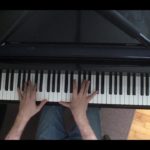Alexander Scriabin (1872 – 1915), Huit études Op 42 (1903)
Performed by Garrick Ohlsson
00:00 – No. 1 D flat major: Presto
01:52 – No. 2 F sharp minor: Crotchet = 112
02:55 – No. 3 F sharp major: Prestissimo
03:53 – No. 4 F sharp major: Andante
07:03 – No. 5 C sharp minor: Affannato
09:56 – No. 6 D flat major: Esaltato
12:09 – No. 7 F minor: Agitato
13:06 – No. 8 E flat major: Allegro
The eight Études Op 42 bring us to 1903. Scriabin was by now an established composer with two symphonies to his credit, and as a pianist was a respected interpreter of his own music. Much was changing personally, philosophically and musically. In 1897 he had married the pianist Vera Ivanovna, but in 1902 Tatyana Schloezer became his pupil; a romance developed and in 1904 Scriabin and Tatyana travelled to Paris together. They married later despite Russian legal complications. Significantly, the Op 42 Études were the last of Scriabin’s piano music that Vera worked on with him.
Around 1900 Scriabin joined the circle around the Moscow philosopher Prince Trubetskoy; the climate in this group tended towards the mystical and apocalyptic. Scriabin also read Nietzsche and later became involved with theosophy. These trends of thought, together with a pampered early upbringing by a devoted aunt, led to an increasingly solipsistic world-view,summed up later in Scriabin’s exclamation to the composer Liadov: ‘I am the creator of new worlds. I am God!’
The Etudes of Op 42 are firmly rooted in tonality but frequently carry chromaticism and metrical complexity to extremes. No 1 is written in a restless cross-rhythm of nine against five; further, the right hand’s melodic groupings go across the bar lines in carefully asymmetrical units of 3, 4, 5 and 6 (later, 5 and 4). Speed, lightness, mobility and ceaseless fluid motion again create the sensation of exhilarating flight.
No 2 exploits Scriabin’s favourite five against three, but here the left-hand figures are shifted across the beats as in Op 8 No 7, giving a feeling of underlying disquiet. This surfaces in the final bars where both hands, as Chopin said of the finale of his B flat minor Sonata which this passage seems to recall, ‘chatter in unison’.
No 3 is a superlative trill study; its ethereal register and chromatic fleetness have earned it the apt Russian nickame of ‘The Mosquito’. Its F sharp major tonality is shared by No 4, an idyllic love song (for Tatyana?).
In violent contrast is No 5, eloquently marked ‘Affanato’—breathless and anxious. This atmosphere is created by a restless, dense texture and a harmonic language in which nearly every chord is darkened and destabilized by the addition of a seventh. An aspiring second subject, one of Scriabin’s finest melodic inspirations, affords some relief from the grip of nightmare.
‘Esaltato’—‘elated’—is the marking of No 6, hinting perhaps at Scriabin’s Nietzschean aspirations; the melodic gestures are imperious, and underlying exhilaration is conveyed not only by constantly swirling cross-rhythms but also by delaying the arrival of the tonic harmony for sixteen bars. This signals an increasing tendency in Scriabin’s music: in its final phase, from 1911 on, tonality became a background element, obliquely referred to but rarely overtly stated. Liszt had hinted at this possibility in the Bagatelle sans tonalité back in 1885, but Scriabin could not have known the piece; it remained unpublished until 1956.
The Brahmsian sixths and rhythmic devices of No 7 are comparatively conservative; this may be the Étude mentioned in a letter of 1899 from the composer to his publisher Belaiev. No 8 shares the first study’s aerial quality, but here the shifting of both hands’ figures across the beat (again in cross-rhythms) creates a weightless, wind-borne impression. By contrast, the central section is solidly grandiose, like that of Op 8 No 7, but its much more advanced harmonic language has a strong foretaste of Scriabin’s next major work, The Divine Poem.




